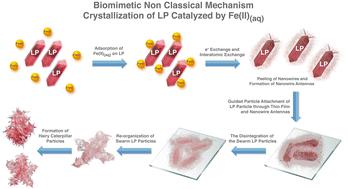当前位置:
X-MOL 学术
›
Environ. Sci.: Nano
›
论文详情
Our official English website, www.x-mol.net, welcomes your
feedback! (Note: you will need to create a separate account there.)
The transformation of lepidocrocite (γ-FeOOH) with Fe(II)(aq) in slightly acidic media: intermediate pathways and biomimetic behavior
Environmental Science: Nano ( IF 5.8 ) Pub Date : 2024-10-11 , DOI: 10.1039/d4en00670d Mario Alberto Gomez, Yiwen Chen, Miao Song, Dongsheng Li, Alan Scott Lea, Shuhua Yao, Yihang Duan, Yongfeng Jia, Yige Cai, Tangfu Xiao
Environmental Science: Nano ( IF 5.8 ) Pub Date : 2024-10-11 , DOI: 10.1039/d4en00670d Mario Alberto Gomez, Yiwen Chen, Miao Song, Dongsheng Li, Alan Scott Lea, Shuhua Yao, Yihang Duan, Yongfeng Jia, Yige Cai, Tangfu Xiao

|
Lepidocrocite (LP) is commonly found in natural or anthropogenic environments and oxidized alloy steel waste storage containers. Despite its importance, the end products formed and its mineral transformation pathways, including intermediate steps and underlying mechanisms under Fe(II)(aq) catalysis still need to be clarified due to decades of dispersed research. In this work, we investigated LP's catalytic transformation with 10 mM and 0.2 mM Fe(II)(aq) at their natural solution pH's via bulk (X-ray Diffraction/XRD, Raman and Attenuated Total Reflectance Fourier Transform Infrared/ATR-FTIR) and micro/nano-scale (semi in situ Transmission Electron Microscopy/TEM) analysis. In general, we observed that goethite (GT) and LP were the main end products. However, a series of two major distinct intermediate events that were initiated by a dissolution type of reaction along with an “induction period” (lack of dissolution) on LP occurred. Fascinatingly, two of the intermediate steps along its mineral transformation presented novel types of non-classical mechanisms of crystallization via some type of guided oriented particle attachment. Furthermore, one of these intermediate steps is biomimetic in appearance, similar to what is observed during bacterial particle attachment. However, it uses inorganic nano-wire antennas that have a sensory-like function as observed with bacterial fimbriae and/or flagellum through an electron transparent film (similar to a bio-film matrix). Finally, this work leads us to comprehend the evolution of some well documented crystal morphologies for GT commonly observed in natural and anthropogenic settings.
中文翻译:

鳞片绿石 (γ-FeOOH) 与 Fe(II)(aq) 在微酸性介质中的转化:中间途径和仿生行为
锂云母 (LP) 常见于自然或人为环境和氧化合金钢废料储存容器中。尽管 Fe(II) 水溶液很重要,但由于数十年的分散研究,形成的最终产物及其矿物转化途径,包括 Fe(II)(aq) 催化下的中间步骤和潜在机制仍需要阐明。在这项工作中,我们通过体(X 射线衍射/XRD、拉曼和衰减全反射傅里叶变换红外/ATR-FTIR)和微/纳米级(半原位透射电子显微镜/TEM)分析,研究了 LP 在其天然溶液 pH 值下使用 10 mM 和 0.2 mM Fe(II)(aq) 的催化转化。总的来说,我们观察到针铁矿 (GT) 和 LP 是主要的最终产品。然而,发生了一系列由溶出型反应引发的两种主要不同的中间事件以及 LP 上的“诱导期”(缺乏溶解)。有趣的是,其矿物转化的两个中间步骤通过某种类型的引导定向颗粒附着呈现了新型的非经典结晶机制。此外,这些中间步骤之一在外观上是仿生的,类似于在细菌颗粒附着过程中观察到的情况。然而,它使用无机纳米丝天线,这些天线具有类似感觉的功能,就像通过电子透明膜(类似于生物膜基质)在细菌菌毛和/或鞭毛中观察到的那样。最后,这项工作引导我们理解在自然和人为环境中常见的一些有据可查的 GT 晶体形态的演变。
更新日期:2024-10-11
中文翻译:

鳞片绿石 (γ-FeOOH) 与 Fe(II)(aq) 在微酸性介质中的转化:中间途径和仿生行为
锂云母 (LP) 常见于自然或人为环境和氧化合金钢废料储存容器中。尽管 Fe(II) 水溶液很重要,但由于数十年的分散研究,形成的最终产物及其矿物转化途径,包括 Fe(II)(aq) 催化下的中间步骤和潜在机制仍需要阐明。在这项工作中,我们通过体(X 射线衍射/XRD、拉曼和衰减全反射傅里叶变换红外/ATR-FTIR)和微/纳米级(半原位透射电子显微镜/TEM)分析,研究了 LP 在其天然溶液 pH 值下使用 10 mM 和 0.2 mM Fe(II)(aq) 的催化转化。总的来说,我们观察到针铁矿 (GT) 和 LP 是主要的最终产品。然而,发生了一系列由溶出型反应引发的两种主要不同的中间事件以及 LP 上的“诱导期”(缺乏溶解)。有趣的是,其矿物转化的两个中间步骤通过某种类型的引导定向颗粒附着呈现了新型的非经典结晶机制。此外,这些中间步骤之一在外观上是仿生的,类似于在细菌颗粒附着过程中观察到的情况。然而,它使用无机纳米丝天线,这些天线具有类似感觉的功能,就像通过电子透明膜(类似于生物膜基质)在细菌菌毛和/或鞭毛中观察到的那样。最后,这项工作引导我们理解在自然和人为环境中常见的一些有据可查的 GT 晶体形态的演变。


















































 京公网安备 11010802027423号
京公网安备 11010802027423号